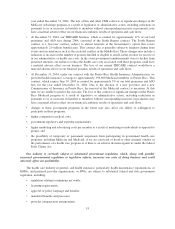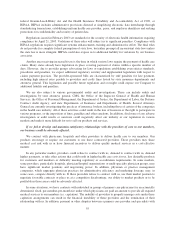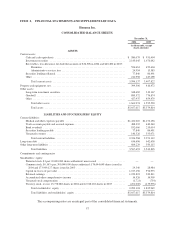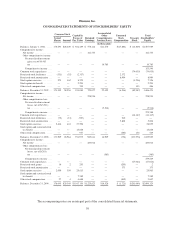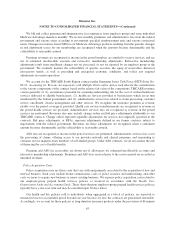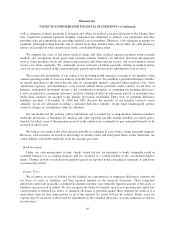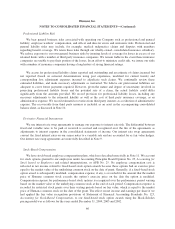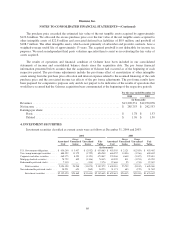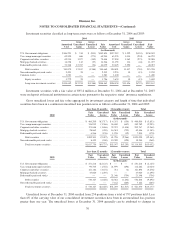Humana 2004 Annual Report Download - page 71
Download and view the complete annual report
Please find page 71 of the 2004 Humana annual report below. You can navigate through the pages in the report by either clicking on the pages listed below, or by using the keyword search tool below to find specific information within the annual report.Humana Inc.
NOTES TO CONSOLIDATED FINANCIAL STATEMENTS
1. REPORTING ENTITY
Nature of Operations
Headquartered in Louisville, Kentucky, Humana Inc. is one of the nation’s largest publicly traded health
benefits companies, based on our 2004 revenues of $13.1 billion. References throughout this document to “we,”
“us,” “our,” “Company,” and “Humana,” mean Humana Inc. and all entities we own. We offer coordinated
health insurance coverage and related services through a variety of traditional and Internet-based plans for
employer groups, government-sponsored programs, and individuals. In 2004, approximately 37% of our
premiums and administrative services fees resulted from employer-group and individual contracts covering
members located in Texas, Illinois, Florida, Kentucky and Ohio. We derived approximately 43% of our
premiums and administrative services fees from contracts with the federal government in 2004. Under a federal
government contract with the Department of Defense, we provide health insurance coverage to TRICARE
members, accounting for approximately 17% of our total premiums and administrative services fees in 2004.
Under one federal government contract with the Centers for Medicare and Medicaid Services, or CMS, we
provide health insurance coverage for Medicare Advantage members in Florida, accounting for approximately
15% of our total premiums and administrative services fees in 2004.
We manage our business with two segments: Commercial and Government. The Commercial segment
consists of members enrolled in products marketed to employer groups and individuals, and includes three lines
of business: fully insured medical, administrative services only, or ASO, and specialty. The Government segment
consists of members enrolled in government-sponsored programs, and includes three lines of business: Medicare
Advantage, Medicaid, and TRICARE. We identified our segments in accordance with the aggregation provisions
of Statement of Financial Accounting Standards No. 131, Disclosures About Segments of an Enterprise and
Related Information which is consistent with information used by our Chief Executive Officer in managing our
business. The segment information aggregates products with similar economic characteristics. These
characteristics include the nature of customer groups and pricing, benefits and underwriting requirements.
The accounting policies of each segment are the same and are described in Note 2. The results of each
segment are measured by income before income taxes. We allocate all selling, general and administrative
expenses, investment and other income, interest expense, and goodwill, but no other assets or liabilities, to our
segments. Members served by our two segments often utilize the same medical provider networks, enabling us to
obtain more favorable contract terms with providers. Our segments also share overhead costs and assets. As a
result, the profitability of each segment is interdependent.
2. SUMMARY OF SIGNIFICANT ACCOUNTING POLICIES
Basis of Presentation
Our financial statements and accompanying notes are prepared in accordance with accounting principles
generally accepted in the United States of America. Our consolidated financial statements include the accounts of
Humana Inc., and its majority-owned subsidiaries. All significant intercompany balances and transactions have
been eliminated. Certain reclassifications have been made to our prior years’ consolidated financial statements to
conform to the current year presentation. These reclassifications had no effect on previously reported
consolidated revenues, net income, or stockholders’ equity.
The preparation of financial statements in accordance with generally accepted accounting principles requires
us to make estimates and assumptions that affect the amounts reported in the financial statements and
accompanying notes. The areas involving the most significant use of estimates are the estimation of medical
expenses payable, the recognition of revenue related to our TRICARE contracts, the valuation and related
impairment recognition of investment securities, and the valuation and related impairment recognition of long-
lived assets, including goodwill. These estimates are based on knowledge of current events and anticipated future
events, and accordingly, actual results may ultimately differ materially from those estimates.
61




